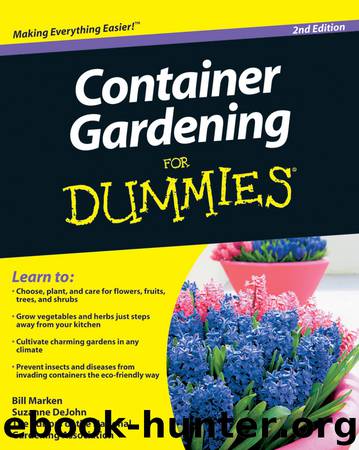Container Gardening For Dummies by Bill Marken

Author:Bill Marken
Language: eng
Format: epub
Publisher: Wiley
Published: 2010-03-08T16:00:00+00:00
Chapter 13
Nurturing Fruits and Berries
In This Chapter
Getting a quick course in fruit and berry biology
Discovering the characteristics of winning candidates for containers
Finding out what fruit producers need
Looking at the plants you have to pick from
While growing flowers and vegetables in containers can be a snap, growing fruit trees and berries takes a little more forethought. You need to become familiar with such things as rootstocks, pollination, and climate adaptation. You may need to prune and thin. We get to all those details in this chapter, but first, the good news.
Growing your own fruit is tremendously rewarding. Nothing, and we mean nothing, tastes better than homegrown fruit harvested at peak ripeness. Imagine the pleasure of adding a handful of blueberries or strawberries to your cereal in the morning or serving an apple pie made with home-grown fruit from the tree on your deck. And fruiting plants can also be quite good-looking — many have colorful, fragrant flowers, attractive foliage, and, of course, beautiful fruit.
Many types of fruits and berries adapt nicely to growing in containers. And plant breeders continue to develop compact varieties especially suited to container growing. Growing fruit in containers has advantages, as well. Most noteworthy is the mobility that containers provide. If frost threatens, you can move your fruit trees under cover for protection. So although container fruit growing takes a little more effort than growing flowers or vegetables, the payoffs are well worth it. In the second half of this chapter, we list berry plants and fruit trees that are easy to grow in containers, and we give you some tips for each one to help make your efforts fruitful (pun intended!).
A Bowl of Fruit Facts
Before you can set off on your growing adventure, you need to pack in a few fruit-gardening terms and concepts that come up again and again in this chapter. We concentrate on deciduous fruit trees (apples, peaches, and so on) because they’re the most complex and also the most rewarding. The following sections explain the biology of how trees come to bear fruit and how normally large fruit trees are cultivated to be suitable for container gardening.
Pollinating: It’s the bee’s knees
You probably remember from Biology 101 all about how pollen moves from the male part of the flower to the female part, fertilizing it, and causing a fruit to grow. Some fruit trees, like peaches, have compatible male and female flower parts on the same plant — this kind of plant is called self-fruitful. You can grow one peach tree — or other self-fruitful plant — by itself, and it will produce fruit.
Other fruits, including some apples and blueberries, produce more and better quality fruit if they’re cross-pollinated, which means that they receive pollen from another variety. You can grow one apple or one blueberry plant and probably get some fruit, but you’ll get much better production if you have a second, different variety growing nearby. For example, if you plant one or two Bluecrop blueberries, you’ll get some fruit,
Download
This site does not store any files on its server. We only index and link to content provided by other sites. Please contact the content providers to delete copyright contents if any and email us, we'll remove relevant links or contents immediately.
| Container Gardening | Hydroponics |
| Organic | Propagation & Cultivation |
| Topiary | Urban |
| Water Gardens & Ponds |
Turbulence by E. J. Noyes(7918)
The Thirst by Nesbo Jo(6806)
Gerald's Game by Stephen King(4554)
Be in a Treehouse by Pete Nelson(3922)
Marijuana Grower's Handbook by Ed Rosenthal(3605)
The Sprouting Book by Ann Wigmore(3529)
The Red Files by Lee Winter(3356)
The Remains of the Day by Kazuo Ishiguro(3279)
Sharp Objects: A Novel by Gillian Flynn(2939)
Christian (The Protectors Book 1) by L. Ann Marie(2644)
Organic Mushroom Farming and Mycoremediation by Tradd Cotter(2616)
The Culinary Herbal by Susan Belsinger(2420)
Stone Building by Kevin Gardner(2336)
The Starter Garden Handbook by Alice Mary Alvrez(2269)
Lilac Girls by Martha Hall Kelly(2243)
The Unlikely Pilgrimage of Harold Fry by Rachel Joyce(2202)
The Lean Farm Guide to Growing Vegetables: More In-Depth Lean Techniques for Efficient Organic Production by Ben Hartman(2084)
Urban Farming by Thomas Fox(2054)
Backyard Woodland by Josh VanBrakle(1879)
